If you’ve ever wondered how much space do northwestern GA frogs need, youre not alone. A lot of people especially new frog hobbyists or just plain curious nature lovers think frogs can thrive in just about any damp patch of grass or muddy ditch. And okay, yes—frogs are pretty low maintenance compared to, say, dogs or cats.
But that doesn’t mean they don’t need their own cozy little territory to hop around in, especially the ones native to Northwestern Georgia. It’s not just about giving them water and bugs; it’s about understanding their habitat needs, how much space makes ’em happy, and even how that space changes depending on the season. Let’s break it down—frog legs and all (joking, don’t worry).
Table of Contents
Why Frog Space Even Matters
First of all, frogs aren’t just sitting there croaking for fun—they’re living beings with instincts. They’re territorial in their own froggy way. And just like we wouldn’t wanna live in a cramped, one-room apartment with 6 roommates and no Wi-Fi (okay, some might), frogs also get a little weird when they don’t have enough space. When frogs are squished into too-tight environments, a few things happen:
- They get stressed (yes, even frogs stress out).
- They might get aggressive toward other frogs.
- Disease can spread faster when they’re too close together.
- And they just don’t behave naturally—less hopping, less calling, less everything.
So, whether you’re trying to build the perfect backyard frog pond or just observing wild frogs in Northwestern GA, space is kind of a big deal.
What Frogs Are We Even Talking About?
Okay, so before we go assigning square footage to frogs like they’re buying condos, let’s be clear on which frogs live in Northwestern Georgia. A few common ones include:
- Green Tree Frogs
- Spring Peepers
- American Bullfrogs
- Southern Leopard Frogs
Each of these has different space and environmental needs, though there’s some overlap. The biggest difference usually depends on their size, diet, and activity level. For example, Bullfrogs are big and bossy. They need more room to move (and eat just about anything that moves), while Spring Peepers are small and a bit more shy.

Wild Frogs vs. Pet Frogs: Different Needs
There’s a huge difference between wild frogs and frogs you’re keeping in an enclosure or backyard pond. So we’ll break it into two categories here:
For Wild Frogs in Northwestern GA
If you’re just trying to make your yard frog-friendly or studying frogs in the wild, here’s what to know:
- Wild frogs generally need about 5 to 10 square feet per frog in natural, healthy ecosystems.
- They don’t stay in one spot. They move between breeding ponds, feeding grounds, and places to hide.
- Seasonal migration is a thing. In spring and summer, they want shallow water and shady spots. In colder months? They burrow or hide under leaves.
So if you’re building a frog habitat in your backyard, try to mimic nature. That means:
- Ponds with shallow and deep areas
- Native plants for hiding and hunting
- Logs, rocks, and damp soil
- No pesticides, please
For Pet Frogs or Captive Enclosures
Now if you’re keeping frogs in a tank or enclosure, space is more critical. There’s less “escape room” and no wild backup habitat. So here’s a rough idea of how much space per frog:
| Frog Type | Minimum Tank Size (for 1 frog) | Space per Additional Frog |
|---|---|---|
| Green Tree Frog | 10 gallons | +5 gallons per frog |
| American Bullfrog | 30 gallons | +10 gallons per frog |
| Southern Leopard Frog | 15 gallons | +5-10 gallons |
| Spring Peeper | 5-10 gallons | +2-3 gallons |
Important Note: Vertical space is just as important as horizontal! Especially for tree frogs, which like to climb.
Also, ventilation and cleanliness matter. A cramped tank isn’t just uncomfortable—it’s a breeding ground for bacteria. And nobody wants a stinky frog tank (trust me).
What About Breeding Frogs?
If you’re tryna breed frogs (hey, no judgment), the space game changes big time. Breeding pairs will need more water, more space, and more privacy. And let’s be honest: frog eggs and tadpoles multiply like crazy. So if you don’t wanna end up with hundreds of tiny frogs and nowhere to put them, plan ahead. A shallow breeding pond should be at least 50-100 gallons, especially if it’ll house multiple pairs.
Signs Your Frogs Need More Space
How do you know if your frogs are feelin’ the squeeze? Watch out for:
- Lethargy (frogs being lazy isn’t normal if they’re usually active)
- Aggression (biting, chasing, hogging food)
- Fungal or skin issues
- Not eating or weird behavior
If that’s happening, it’s probably time to upgrade their setup or thin out the group.
Final Thoughts:
So, how much space do Northwestern GA frogs need? It really depends on the frog, whether it’s wild or kept as a pet, and what kind of habitat it’s chillin’ in. But one thing’s clear—more space = happier frogs. If you’re keeping frogs, be generous with your setup. If you’re trying to support them in the wild, make your yard a little more froggy-friendly.
Because let’s be real—these slimy, jumpy little guys are part of what makes Georgia’s natural world so dang cool. And all they ask in return? A little room to hop, sing, and snack on bugs.

